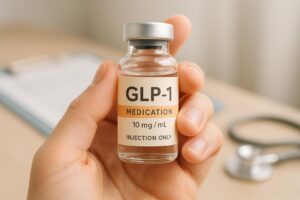How the Body Makes GLP-1: Understanding the Mechanisms Behind This Essential Hormone

The human body is an intricate system, constantly working to maintain balance and regulate numerous functions, from metabolism to appetite control. One of the critical players in this process is a hormone known as glucagon-like peptide-1, or GLP-1. Though many may not have heard of GLP-1 until recently, it has long been a crucial component of our physiological makeup. This hormone plays a significant role in regulating blood sugar levels, stimulating insulin secretion, and enhancing feelings of fullness, making it a focal point in discussions about weight management and metabolic health.
With the rise of obesity and diabetes rates worldwide, understanding how the body produces GLP-1 has never been more relevant. By the end of this blog post, we aim to provide you with a comprehensive understanding of how the body creates GLP-1, its functions, and its implications for weight management and overall health. We’ll explore everything from the cellular mechanisms involved in GLP-1 production to the impact of dietary choices on this hormone’s levels.
Introduction
Have you ever wondered why some meals leave you feeling fuller longer than others? The answer may lie in a hormone produced by your gut called GLP-1. Recent studies suggest that GLP-1 is not just a buzzword in the realm of weight loss medications; it’s a naturally occurring hormone essential for appetite regulation and glucose metabolism.
Historically, GLP-1 was primarily associated with diabetes management, but its importance in weight management has gained significant attention in recent years.
In this blog post, we will delve into the following key areas:
- What is GLP-1? An overview of the hormone and its functions.
- How does the body produce GLP-1? A detailed look at the physiological processes involved.
- The impact of diet on GLP-1 levels. Exploring which foods can enhance GLP-1 production.
- GLP-1 and weight management. Understanding how it influences appetite and weight loss.
- The role of GLP-1 medications. How modern medicine is leveraging this hormone to aid in weight loss.
Through this exploration, we hope to empower you with knowledge about GLP-1 and perhaps inspire you to consider how your dietary choices may impact your health journey. Together, let’s discover the fascinating world of GLP-1 and its critical role in our bodies.
What is GLP-1?
GLP-1, or glucagon-like peptide-1, is a 30-amino acid peptide hormone primarily produced in the L-cells of the small intestine. It is classified as an incretin hormone, which means it is secreted in response to food intake and plays a pivotal role in regulating insulin secretion.
Functions of GLP-1
GLP-1 serves several essential functions in the body:
-
Stimulates Insulin Secretion: One of the primary roles of GLP-1 is to enhance insulin secretion from the pancreas in response to food intake. This action helps to lower blood sugar levels after meals.
-
Inhibits Glucagon Release: GLP-1 suppresses the release of glucagon, a hormone that raises blood sugar levels, thus contributing to overall glucose homeostasis.
-
Slows Gastric Emptying: By slowing the rate at which food leaves the stomach, GLP-1 helps to prolong feelings of fullness, reducing overall food intake.
-
Reduces Appetite: GLP-1 acts on the brain’s appetite centers to help curb hunger, promoting a sense of satiety.
These functions make GLP-1 a critical player in both diabetes management and weight management strategies.
How Does the Body Produce GLP-1?
The production of GLP-1 is a complex process that begins in the gut but is influenced by multiple factors, including dietary intake and hormonal signaling. Here’s a step-by-step breakdown of how GLP-1 is synthesized and released in the body:
1. Food Intake and Nutrient Absorption
The journey of GLP-1 production starts when we consume food. Specifically, the presence of carbohydrates, proteins, and fats in the gastrointestinal tract triggers the secretion of GLP-1.
2. Role of the Proglucagon Gene
GLP-1 is derived from a larger precursor protein called proglucagon. This protein is synthesized in the L-cells of the intestine and is processed into several peptides, including GLP-1.
3. Posttranslational Processing
Once proglucagon is produced, it undergoes posttranslational modifications. This process involves cleaving the proglucagon molecule into smaller peptides, including GLP-1. The enzymatic activity of specific peptidases, particularly the enzyme prohormone convertase, is crucial in this stage.
4. Release into the Circulation
After it is produced, GLP-1 is released into the bloodstream in response to nutrient intake. Its levels typically begin to rise within 10 to 15 minutes after eating, reaching peak levels within one hour.
5. Degradation and Inactivation
GLP-1 is rapidly metabolized by the enzyme dipeptidyl peptidase-4 (DPP-4), which breaks down the hormone into inactive forms. This rapid degradation is why GLP-1 has a short half-life, necessitating the development of GLP-1 receptor agonist medications that mimic its effects over a longer duration.
Summary of GLP-1 Production
In summary, GLP-1 production is a dynamic process that involves the synthesis of proglucagon, its conversion to GLP-1 through enzymatic actions, and its eventual release in response to food intake. Understanding this process provides insight into how dietary choices can influence GLP-1 levels and, consequently, metabolic health.
The Impact of Diet on GLP-1 Levels
Diet plays a pivotal role in influencing GLP-1 production. Certain foods can enhance the secretion of this hormone, while others may not have the same effect. Let’s explore the dietary components that can boost GLP-1 levels.
1. Fiber-Rich Foods
Research indicates that dietary fiber is one of the most effective ways to stimulate GLP-1 secretion. Foods high in soluble fiber, such as oats, barley, fruits, and legumes, can promote the fermentation process in the gut, leading to increased production of GLP-1.
- Mechanism: When fiber reaches the large intestine, it is fermented by gut microbiota, producing short-chain fatty acids (SCFAs) that signal L-cells to release GLP-1.
2. Protein Sources
High-protein foods, such as lean meats, fish, eggs, and dairy products, have also been shown to stimulate GLP-1 secretion. Proteins can enhance satiety and prolong the feeling of fullness by increasing GLP-1 levels.
3. Healthy Fats
Incorporating healthy fats into meals can also trigger GLP-1 release. Foods such as avocados, nuts, and olive oil are beneficial not only for overall health but also for increasing GLP-1 levels.
4. Low Glycemic Index Foods
Foods with a low glycemic index (GI), such as whole grains and most fruits and vegetables, can promote steady blood sugar levels and enhance GLP-1 secretion. This helps prevent the rapid spikes and crashes often associated with high-GI foods.
Conclusion on Diet and GLP-1
By making informed dietary choices, individuals can naturally enhance their GLP-1 production, thereby supporting metabolic health and weight management. Emphasizing a diet rich in fiber, protein, and healthy fats can be an effective strategy for those looking to optimize their GLP-1 levels.
GLP-1 and Weight Management
Understanding GLP-1’s role in weight management is crucial, especially in the context of the rising obesity epidemic. GLP-1 is not only a key player in insulin regulation but also significantly influences appetite and satiety.
How GLP-1 Affects Appetite
Research has shown that GLP-1 can effectively reduce appetite and food intake. This is achieved through various mechanisms:
-
Satiety Signals: By acting on the hypothalamus, GLP-1 helps to signal fullness, reducing the desire to eat more food.
-
Slowed Gastric Emptying: As previously mentioned, GLP-1 slows down the rate at which food leaves the stomach, prolonging the sensation of fullness.
-
Neurotransmitter Regulation: GLP-1 influences the release of neurotransmitters that are responsible for hunger signals, thereby helping to curb cravings.
The Role of GLP-1 Medications
In recent years, GLP-1 receptor agonists, such as semaglutide (found in medications like Ozempic and Wegovy) and tirzepatide (Mounjaro), have been developed to mimic the effects of naturally occurring GLP-1. These medications have shown remarkable success in promoting weight loss and improving metabolic health.
-
Clinical Evidence: Studies have demonstrated that individuals taking GLP-1 receptor agonists can achieve significant weight loss compared to those who do not. For instance, clinical trials have shown that participants can lose an average of 15% of their body weight over a treatment period.
-
Sustained Action: Unlike natural GLP-1, which is rapidly degraded, these medications are designed to have a longer duration of action, allowing for more sustained effects on appetite and weight management.
Conclusion on GLP-1 and Weight Management
GLP-1 plays a vital role in weight management by influencing appetite regulation and satiety. With the advent of GLP-1 receptor agonist medications, individuals struggling with weight can now leverage the benefits of this hormone in a controlled and effective manner.
Conclusion
In conclusion, understanding how the body makes GLP-1 provides valuable insights into its crucial role in regulating appetite, blood sugar levels, and weight management. From the intricate processes of proglucagon synthesis to the impact of dietary choices on GLP-1 secretion, it is clear that this hormone is a pivotal player in our metabolic health.
For those looking to optimize their weight loss journey, embracing a diet rich in fiber, protein, and healthy fats can naturally enhance GLP-1 levels. Moreover, the growing availability of GLP-1 receptor agonist medications offers new avenues for those seeking effective weight management solutions.
As we continue to explore the relationship between GLP-1 and health, it’s essential to remember that personalized approaches to weight loss and metabolic health can lead to sustainable results. At TrimRx, we are dedicated to providing personalized weight loss solutions that prioritize safety and effectiveness.
By understanding the science behind GLP-1 and its implications for health, we can make informed choices that support our well-being.
FAQ
What triggers the release of GLP-1?
GLP-1 is primarily triggered by food intake, particularly carbohydrates, proteins, and fats. The presence of these nutrients in the gut stimulates L-cells to release GLP-1 into the bloodstream.
How does GLP-1 help with weight management?
GLP-1 promotes feelings of fullness, slows gastric emptying, and reduces appetite. These effects can lead to decreased food intake and, subsequently, weight loss.
Can I increase my GLP-1 levels naturally?
Yes, you can enhance GLP-1 levels by consuming a diet rich in fiber, proteins, and healthy fats. Foods such as whole grains, legumes, lean meats, and avocados can be particularly beneficial.
Are GLP-1 medications safe?
GLP-1 medications have been shown to be effective for weight management and diabetes control. However, they should be used under medical supervision, as they can have side effects and may not be suitable for everyone.
How quickly does GLP-1 act in the body?
GLP-1 levels begin to rise 10-15 minutes after eating and peak within an hour. However, the hormone is rapidly degraded, which is why GLP-1 receptor agonists are used to provide sustained effects.
For those interested in embarking on a personalized weight loss journey, we invite you to take our free assessment quiz to see if you qualify for our prescription weight loss medications. Together, we can work towards achieving your health goals.

Transforming Lives, One Step at a Time
Keep reading
Tracking Progress With GLP-1: What To Measure
Learn which metrics to track on GLP‑1 therapy—weight, waist, blood sugar, lipids, side effects, and non‑scale wins—and how often to monitor them.
Fatigue Solutions for Ozempic and Wegovy Users
Hydration, protein-rich meals, light activity, and better sleep can reduce medication-related fatigue and help maintain energy during weight-loss treatment.
GLP-1 Medication Side Effect Checker
Worried about GLP-1 medication side effects? Use our free checker for Semaglutide, Liraglutide, and more to learn what to expect and stay informed!



